Abstract:
This book tells the story of the indigenous inhabitants of Saba prior to European colonization, based on 30 years of archaeological research conducted by Leiden University in collaboration with the government and people of Saba.
The pre-colonial history of Saba begins around 3800 years ago with the first fishers-foragers and plant managers occupying the interior of the island at Plum Piece, Fort Bay, The Level and Great Point. The exceptional character of Saba with its volcano, diverse vegetation, and fauna, attracted Amerindian communities from the prime episode of human occupation of the insular Caribbean, first on a temporary basis and later, from AD 400 on, permanently. They then settled in Spring Bay, Kelbey’s Ridge, Windwardside, St. Johns, and The Bottom just like today. Their villages consisted of a series of dwellings of wood, fibres and leafs, surrounded by hearths and garbage dumps. The deceased were buried in the village, often under the floor of the houses.
The Amerindians on Saba maintained extensive relationships with communities and kin on neighbouring islands. The artefacts which have been found on Saba show these connections.
Contents
Foreword
by Jay B. Haviser
Preface
by Corinne L. Hofman and Menno L.P. Hoogland
1. Saba, an isolated island?
Island setting
Amerindian settlement patterns
2. Pre-Colonial history of Saba
Amerindian occupation of Saba
Tales of the Europeans
3. Island life 3800 years ago
Saba’s first inhabitants
4. Fishers, collectors, foragers and horticulturalists
Village life
Handicrafts
Worldview
5. Archaeologiscal sites on Saba before 1492
Archaeological investigations on Saba
Guided tour of major Amerindian sites


Prof. dr.
Corinne L. Hofman
Corinne L. Hofman is Professor of Caribbean Archaeology at the Faculty of Archaeology, Leiden University, the Netherlands. She has conducted fieldwork – together with Dr. Menno Hoogland – in many of the Caribbean islands over the past 30 years.
read more

Prof. dr.
Menno M.L.P Hoogland
Menno Hoogland is associate professor in Caribbean archaeology. He was born in 1954 in Sliedrecht, studied cultural anthropology in Leiden with a focus on prehistory and physical anthropology. In 1980 he participated in the Spitsbergen expedition of the University of Groningen. He wrote his PhD thesis on settlement patterns of the Amerindian population of Saba, Netherlands Antilles.
read more









